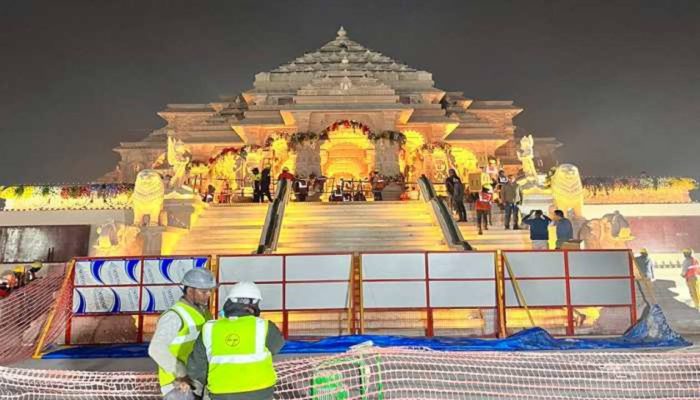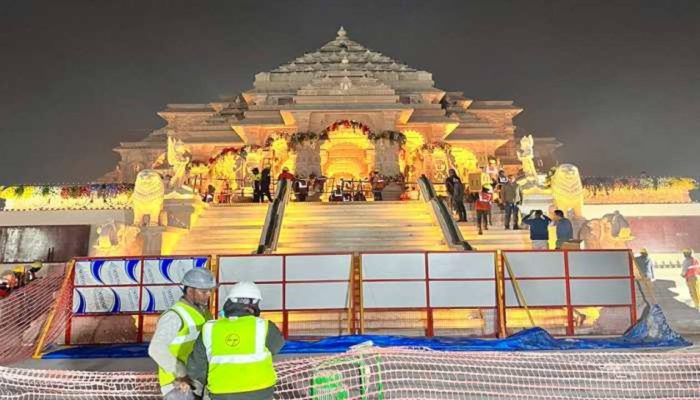Your Spiritual Retreat: A Short Ayodhya Vacation Guide

Ayodhya, the ancient city steeped in spiritual significance and legendary tales, has witnessed a remarkable resurgence, drawing pilgrims and tourists from across the globe. With the grand inauguration of the Ram Mandir, this revered destination has become a must-visit for anyone seeking a profound spiritual and cultural experience. If you're contemplating a short Ayodhya vacation, this informative guide will help you plan an unforgettable journey, ensuring you embrace the city's divine aura and explore its rich heritage.
The Allure of Ayodhya: More Than Just a Destination
Ayodhya, nestled on the banks of the sacred Saryu River in Uttar Pradesh, is believed to be the birthplace of Lord Rama, the seventh avatar of Vishnu. Its very essence resonates with devotion, history, and mythology. A visit here isn't just about sightseeing; it's a journey into the heart of Hindu faith and an opportunity to connect with ancient traditions. The city beautifully blends its historical roots with modern developments, making it accessible and welcoming to all.
Planning Your Short Ayodhya Vacation: A 2-3 Day Itinerary
A short trip, ideally 2 to 3 days, allows ample time to soak in the spiritual atmosphere and visit the key attractions without feeling rushed.
Day 1: Arrival and the Heart of Devotion
Morning: Arrival and Check-in Ayodhya is well-connected by air, rail, and road. The Maharishi Valmiki International Airport (Ayodhya Dham) offers direct flights from major Indian cities, making air travel the fastest option. Alternatively, Ayodhya Cantt and Ayodhya Dham Junction are well-connected railway stations. For those preferring road travel, buses and private taxis are readily available from nearby cities like Lucknow (approx. 130 km) and Varanasi (approx. 200 km).
Upon arrival, check into your accommodation. Ayodhya offers a range of options, from budget-friendly guesthouses and dharamshalas to mid-range and luxury hotels. Consider hotels like Amritara Ramila Kutir, Shree Ram Sharanam Guest House, Hotel RamBhoomi Ayodhya, or The Ramayana Hotel for a comfortable stay. Many accommodations are located conveniently close to the Ram Mandir and other significant sites.
Afternoon: The Ayodhya Ram Mandir Visit No Ayodhya vacation is complete without a deeply moving Ayodhya Ram Mandir visit. The newly constructed temple is the spiritual centerpiece of the city. The temple is generally open for darshan from 6:30 AM to 11:30 AM and then again from 2:00 PM to 9:30 PM. It's advisable to check the latest timings and any special guidelines before your visit, especially during festivals. Mobile phones, cameras, and large bags are generally not allowed inside, so utilize the locker facilities available. The experience of witnessing the grandeur of the temple and feeling the palpable devotion is truly awe-inspiring.
Evening: Hanuman Garhi and Saryu Aarti After your Ram Mandir visit, make your way to Hanuman Garhi. This fort-like temple, dedicated to Lord Hanuman, requires climbing 76 steps, but the panoramic views of Ayodhya from the top are well worth it. It's believed that seeking Lord Hanuman's blessings here before visiting Lord Rama is auspicious.
As dusk approaches, head to the Saryu Ghat for the mesmerizing evening aarti. The banks of the Saryu River come alive with the glow of countless diyas (oil lamps), devotional chants, and the rhythmic movements of the priests. You can also opt for a serene boat ride on the river during sunset, a truly peaceful experience that deepens your connection with the spiritual essence of Ayodhya.
Day 2: Exploring Ancient Legends and Cultural Gems
Morning: Kanak Bhawan and Dashrath Mahal Begin your second day with a visit to Kanak Bhawan, also known as the "Golden Palace." This exquisitely adorned temple is believed to have been gifted to Goddess Sita by Queen Kaikeyi after her marriage to Lord Rama. The golden idols of Rama and Sita housed within exude an aura of divine opulence and tranquility.
Next, visit Dashrath Mahal, the ancient palace of King Dashrath, Lord Rama's father. While much of the original structure is no longer present, the site holds immense historical and mythological significance, offering a glimpse into the royal lineage of Ayodhya.
Afternoon: Treta Ke Thakur and Sita Ki Rasoi Continue your exploration with Treta Ke Thakur, a historic temple believed to be the spot where Lord Rama performed the Ashwamedha Yagya. The ancient black stone idols within the temple contribute to its profound spiritual ambiance.
Nearby, explore Sita Ki Rasoi, a small temple believed to be the kitchen used by Sita. While it's now a temple-like space, it houses symbolic kitchen items and offers a unique insight into the domestic aspects of the Ramayana era.
Evening: Guptar Ghat and Local Market Head to Guptar Ghat, a tranquil spot on the Saryu River, slightly away from the main city. This ghat holds profound significance as it is believed to be the place where Lord Rama took his final earthly journey by immersing himself in the Sarayu River. It's an ideal location for quiet contemplation and reflection.
Conclude your day by exploring the local markets around Ramkot and Hanuman Garhi. You can find a variety of souvenirs, religious artifacts, books on Ramayana, brass idols, and local handicrafts.
Day 3: A Deeper Dive or Departure
Morning: Nageshwarnath Temple and Ram Katha Museum For your final day, visit Nageshwarnath Temple, an ancient Shiva shrine believed to have been established by Kush, Lord Rama's son. The temple's historical architecture and serene setting make it a significant spiritual stop.
If time permits, immerse yourself in the rich narratives of the Ramayana at the Ram Katha Museum. This museum houses a collection of artifacts, sculptures, paintings, and manuscripts that vividly narrate the epic tale and Ayodhya's cultural heritage.
Late Morning/Afternoon: Departure Depending on your travel schedule, you can enjoy a final local meal or revisit a favorite spot before heading to the airport or railway station for your onward journey.
Ayodhya's Culinary Delights: A Pure Vegetarian Experience
Ayodhya's cuisine is predominantly vegetarian and reflects the city's spiritual ethos. Many local eateries and ashrams serve sattvic food, prepared without onion or garlic.
Sattvic Thali: Experience a traditional vegetarian meal comprising seasonal vegetables, dal, puri or chapati, rice, and sweets. Look for bhojanalayas like Ram Rasoi or Annapurna Bhojanalaya.
Street Food: Indulge in local favorites like crispy Aloo Tikki Chaat with tangy chutneys, and hot Kachori-Sabzi for breakfast. You'll find numerous street stalls near Ram Ki Paidi and Hanuman Garhi.
Sweets: Don't miss the local sweets made with pure desi ghee. Try peda, laddoos, balushahi, and imarti from renowned sweet shops like Ramnagari Misthan Bhandar.
Lassi & Thandai: Cool off with thick, creamy lassi or the refreshing thandai, especially during warmer months.
Practical Tips for Your Ayodhya Vacation
Best Time to Visit: The winter months, from October to March, offer the most pleasant weather for exploring Ayodhya. Summers (April-June) can be very hot.
Dress Code: When visiting temples and religious sites, dress modestly, covering your shoulders and knees.
Connectivity: Ayodhya has improved its infrastructure significantly. While connectivity is good, it's advisable to book your accommodation and travel well in advance, especially during peak seasons or festivals like Ram Navami and Diwali.
Getting Around: Auto-rickshaws, battery-operated rickshaws, and e-buses are common modes of transport within Ayodhya. Taxis can also be hired for more comfortable travel. Golf carts are available within the Ram Mandir complex, prioritizing senior citizens and differently-abled visitors.
Budgeting: A 2-3 day short Ayodhya vacation can range from ₹3,000 to ₹5,000 per person for a budget trip (staying in dharamshalas, eating local street food, using public transport) to ₹6,000 to ₹10,000 for a standard trip (mid-range hotels, dining at local restaurants, mix of public and private transport). Luxury options would naturally cost more.
Safety: Ayodhya is generally safe for travelers. However, it's always wise to be aware of your surroundings, especially in crowded areas.
A short Ayodhya vacation promises a profound spiritual journey, offering a unique blend of ancient reverence and contemporary development. From the majestic Ram Mandir to the serene banks of the Saryu River, every corner of this holy city whispers tales of devotion and heritage, leaving you with memories that will last a lifetime. If you are planning for ayodhya visit at affordable packages get in touch with Ayodhya Pilgrimage now.
Note: IndiBlogHub features both user-submitted and editorial content. We do not verify third-party contributions. Read our Disclaimer and Privacy Policyfor details.



